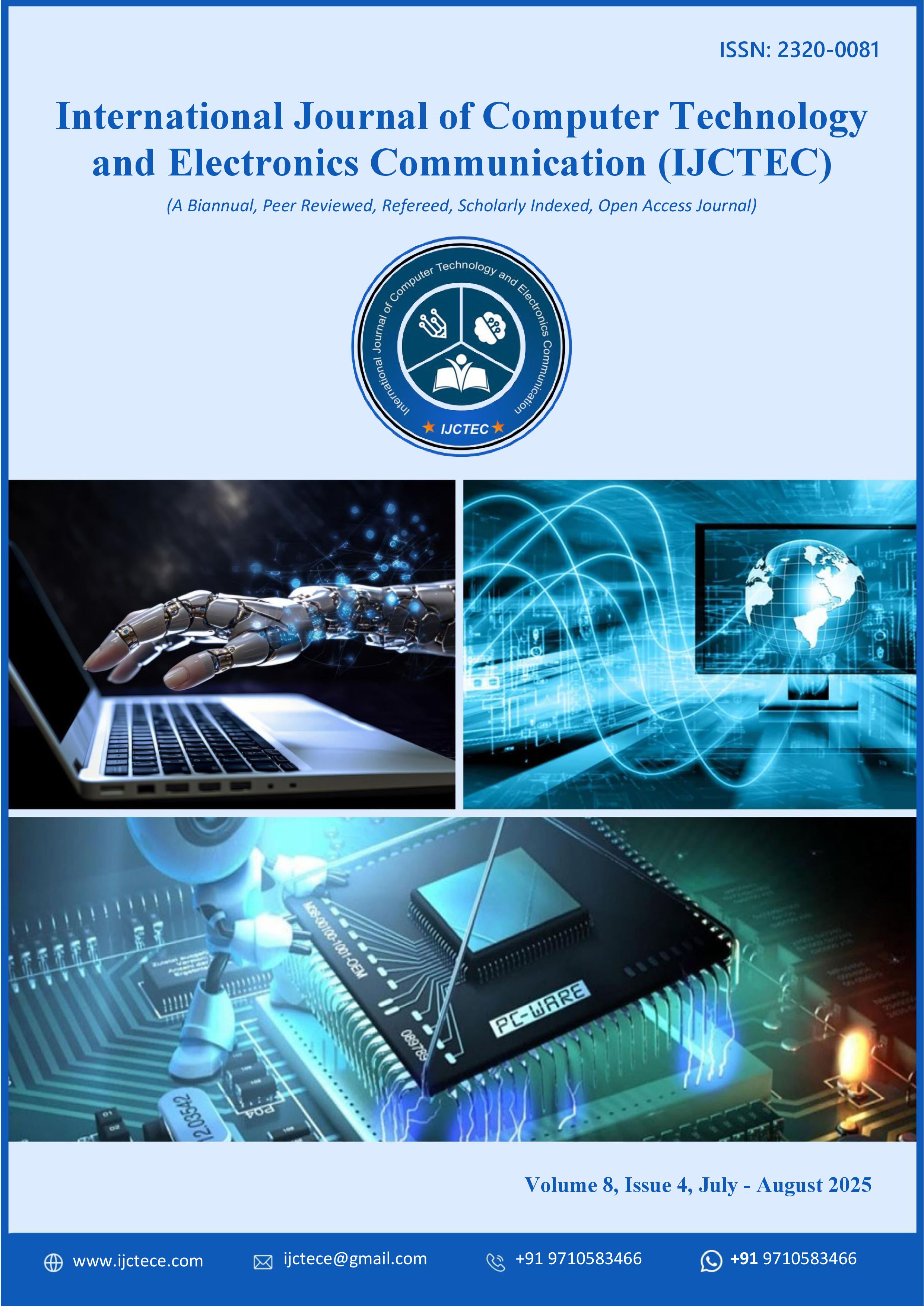Cloud-Native AI Solutions for Scalable Software, BMS Optimization, and Cybersecurity Risk Management
DOI:
https://doi.org/10.15680/IJCTECE.2025.0804006Keywords:
AI-Driven Cloud, Support Vector Machine (SVM), Cybersecurity, Scalable Software, Building Management Systems (BMS), Cloud-Native Architecture, Real-Time Monitoring, Predictive MaintenanceAbstract
The integration of Artificial Intelligence (AI) with cloud computing is transforming software systems and Building Management Systems (BMS) by enhancing scalability, intelligence, and cybersecurity. This study proposes an AI-driven cloud framework that leverages Support Vector Machine (SVM) algorithms to detect and mitigate cyber threats while optimizing software operations and BMS performance. The framework ensures secure, scalable, and efficient management of distributed systems, enabling real-time monitoring, predictive maintenance, and adaptive control. Experimental evaluations demonstrate significant improvements in system responsiveness, threat detection accuracy, and resource utilization. The proposed approach highlights the potential of combining AI, cloud technologies, and machine learning-driven cybersecurity to deliver robust, scalable, and secure enterprise solutions, paving the way for next-generation intelligent infrastructures. By analyzing case studies and current implementations, the paper highlights the benefits, challenges, and future prospects of integrating AI, cloud computing, and immersive technologies in life insurance claims processing. The findings suggest that this technological convergence not only improves operational efficiency but also offers a more personalized and transparent experience for policyholders.
References
1. Asgarian, A., Saba-Sadiya, S., & Moghaddam, H. A. (2023). AutoFraudNet: Cascaded slow fusion network for fraud detection in the auto insurance industry. arXiv preprint arXiv:2301.07526. https://arxiv.org/abs/2301.07526
2. Loadsure. (2022). How Loadsure uses Google AI to eliminate manual processing in insurance claims. Google Cloud Blog. Retrieved October 2024, from https://cloud.google.com/blog/topics/financial-services/loadsure-data-drive-insurance-claims-ai-eliminates-manual-processing
3. Gosangi, S. R. (2023). Reimagining Government Financial Systems: A Scalable ERP Upgrade Strategy for Modern Public Sector Needs. International Journal of Research Publications in Engineering, Technology and Management (IJRPETM), 6(1), 8001-8005.
4. Balaji, P. C., & Sugumar, R. (2025, April). Accurate thresholding of grayscale images using Mayfly algorithm comparison with Cuckoo search algorithm. In AIP Conference Proceedings (Vol. 3270, No. 1, p. 020114). AIP Publishing LLC.
5. Gupta, R., & Sun, J. (2016). Cost-effectiveness of cloud computing in actuarial modeling. IEEE Transactions on Services Computing, 9(5), 689–703. https://doi.org/10.1109/TSC.2016.2571162
6. Amuda, K. K., Kumbum, P. K., Adari, V. K., Chunduru, V. K., & Gonepally, S. (2020). Applying design methodology to software development using WPM method. Journal of Computer Science Applications and Information Technology, 5(1), 1–8. https://doi.org/10.15226/2474-9257/5/1/00146
7. Kou, W., Zhang, Y., & Qiu, M. (2018). Cloud-enhanced actuarial workflows: Collaboration and cost-efficiency. Computers & Industrial Engineering, 119, 387–400. https://doi.org/10.1016/j.cie.2018.03.022
8. Sankar, Thambireddy,. (2024). SEAMLESS INTEGRATION USING SAP TO UNIFY MULTI-CLOUD AND HYBRID APPLICATION. International Journal of Engineering Technology Research & Management (IJETRM), 08(03), 236–246. https://doi.org/10.5281/zenodo.15760884
9. Gosangi, S. R. (2023). Transforming Government Financial Infrastructure: A Scalable ERP Approach for the Digital Age. International Journal of Humanities and Information Technology, 5(01), 9-15.
10. Wang, Y., & Lee, S. (2024). Vision language models and mixed reality in financial customer service: Empathetic virtual agents. arXiv preprint arXiv:2410.12051. https://arxiv.org/abs/2410.12051
11. Narapareddy, V. S. R., & Yerramilli, S. K. (2022). RISK-ORIENTED INCIDENT MANAGEMENT IN SERVICE NOW EVENT MANAGEMENT. International Journal of Engineering Technology Research & Management (IJETRM), 6(07), 134-149.
12. Saqib, M., Mehta, D., Yashu, F., & Malhotra, S. (2024). Adaptive security policy management in cloud environments using reinforcement learning. arXiv preprint arXiv:2505.08837. https://arxiv.org/abs/2505.08837 (Note: Published in 2024, before 2025 cutoff)
13. Azmi, S. K. (2021). Spin-Orbit Coupling in Hardware-Based Data Obfuscation for Tamper-Proof Cyber Data Vaults. Well Testing Journal, 30(1), 140-154.
14. Sangannagari, S. R. (2022). THE FUTURE OF AUTOMOTIVE INNOVATION: EXPLORING THE IN-VEHICLE SOFTWARE ECOSYSTEM AND DIGITAL VEHICLE PLATFORMS. International Journal of Research and Applied Innovations, 5(4), 7355-7367.
15. Reddy, B. V. S., & Sugumar, R. (2025, April). Improving dice-coefficient during COVID 19 lesion extraction in lung CT slice with watershed segmentation compared to active contour. In AIP Conference Proceedings (Vol. 3270, No. 1, p. 020094). AIP Publishing LLC.
16. Gonepally, S., Amuda, K. K., Kumbum, P. K., Adari, V. K., & Chunduru, V. K. (2021). The evolution of software maintenance. Journal of Computer Science Applications and Information Technology, 6(1), 1–8. https://doi.org/10.15226/2474-9257/6/1/00150
17. Gan, C., Schwartz, J., Alter, S., Mrowca, D., Schrimpf, M., Traer, J., ... & Tenenbaum, J. B. (2020). ThreeDWorld: A platform for interactive multi-modal physical simulation. arXiv preprint arXiv:2007.04954. https://arxiv.org/abs/2007.04954
18. Konda, S. K. (2022). STRATEGIC EXECUTION OF SYSTEM-WIDE BMS UPGRADES IN PEDIATRIC HEALTHCARE ENVIRONMENTS. International Journal of Research Publications in Engineering, Technology and Management (IJRPETM), 5(4), 7123-7129.
19. Hendriksen, M., Bleeker, M., Vakulenko, S., van Noord, N., & Kuiper, E. (2021). Extending CLIP for category-to-image retrieval in e-commerce. Proceedings of the IEEE/CVF International Conference on Computer Vision, 10654–10663. https://doi.org/10.1109/ICCV48922.2021.01045
20. Arjunan, T., Arjunan, G., & Kumar, N. J. (2025, May). Optimizing Quantum Support Vector Machine (QSVM) Circuits Using Hybrid Quantum Natural Gradient Descent (QNGD) and Whale Optimization Algorithm (WOA). In 2025 6th International Conference for Emerging Technology (INCET) (pp. 1-7). IEEE
21. Richie, R. C. (2024). Through the looking glass darkly: How may AI models influence future underwriting? Journal of Insurance Medicine, 51(2), 59–63. https://doi.org/10.17849/insm-51-2-59-63.1


